Lewes, Sussex
Up to 1834
A parliamentary report of 1776 listed local workhouses operating at Lewes Borough and at St Thomas in the Cliff, each with accommodation for 30 inmates.
The parish of All Saints, Lewes, had a workhouse on the south side of School Hill. By 1758, the property, by then used as an almshouse, had become run down and the vestry ordered that it should be sold and a new one built. The replacement was erected on St Nicholas Lane and when it was sold in 1869, it consisted of six cottages and another building to its rear. The St Thomas workhouse was on South Street in Lewes. The Lewes parish of St Ann(e) had its own workhouse on the south side of the High Street, just to the east of its junction with St Anne's Crescent, now the site of a reservoir.
After 1834
The Lewes Poor Law Union was formed on 10th August 1835. Its operation was overseen by an elected Board of Guardians, 11 in number, representing its 7 constituent parishes as listed below (figures in brackets indicate numbers of Guardians if more than one):
County of Sussex:
Lewes—All Saints (2), Lewes—St John Baptist Southover, Lewes—St John-under-the-Castle (2), Lewes—St Michael (2), Lewes—St Ann or St Peter and St Mary Without, Lewes—St Thomas-in-the-Cliffs (2), South Malling.
Later Additions:Barcombe, Beddingham, Chailey, Chalvington, East Chiltington, Ditchling, West Firle, Glynde, Hamsey, Newick, Plumpton, Ringmer, Ripe, Streat, Westmeston, Wivelsfield (all from 1898).
The population falling within the Union at the 1831 census had been 9,297 with parishes ranging in size from South Malling (population 705) to Lewes—St John-under-the-Castle (2,421). The average annual poor-rate expenditure for the period 1832-35 had been £5,770 or 12s.5d. per head of the population.
After its formation, Lewes Union continued to use three existing former workhouse premises: All Saints for the elderly, St Thomas in the Cliff (or Cliffe) for the able-bodied, and St Ann's for pauper children. In 1836, the Poor Law Commissioners authorized an expenditure of £900 for the enlargement of these premises.
In 1868, a new workhouse was built at the north side of De Montfort Road, Lewes. Its construction cost £12,700 and it accommodated 205 inmates. Designed by Henry Currey, it had a single-storey entrance block and a corridor-plan main building with numerous gables. A separate infirmary was placed at the north-west of the main building. A school block accommodating forty children was added at the north-east in 1875. The workhouse location and layout are shown on the 1874 map below.
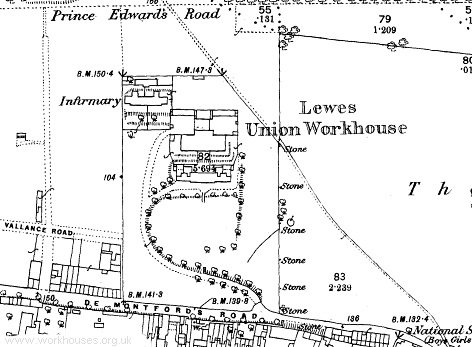
Lewes workhouse site, 1875.
The main building was constructed on a corridor plan and had numerous gables. A single storey entrance block ran along the south of the site.
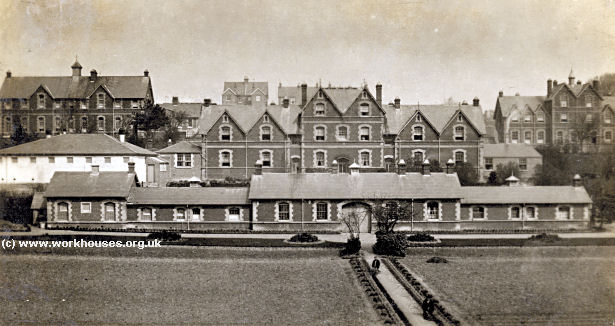
Lewes workhouse from the south, c.1910.
© Peter Higginbotham.
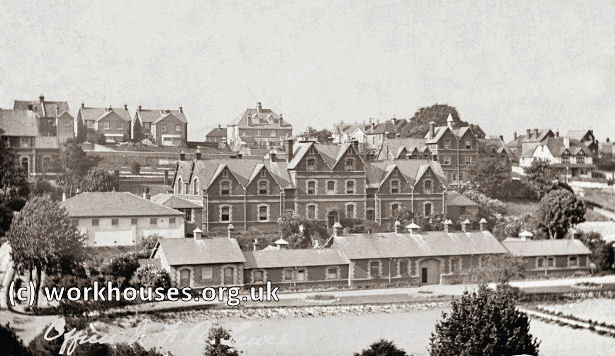
Lewes workhouse from the south, c.1910.
© Peter Higginbotham.
In 1898, Lewes merged with the Chaileyand West Firle Unions, with the new body continuing under the name of Lewes Union. The West Firle and Lewes workhouses were closed and their inmates transferred to the former Chailey Union workhouse at East Chiltington.
The Lewes workhouse was subsequently rented by the Revd Harold Burden, a former missionary, and a leading figure in the creation and operation of reformatories for inebriates at the turn of the 19th century. Following the passing of an Inebriates Act in 1898 which enabled the compulsory detention of criminal inebriates in certified reformatories, Burden set up a charity called the National Institutions for Inebriates (NII). The NII set up a network of institutions, including one in another former workhouse at Guiltcross in Norfolk which opened as the Eastern Counties or East Harling reformatory in 1904. Lewes was the Southern Counties reformatory licensed in November 1902 for 130 female inebriates who were admitted directly from court. Guiltcross took both men and women, and also epileptic and diseased inmates. Due to falling numbers, the Lewes reformatory surrendered its licence as an inebriate reformatory in January 1910.
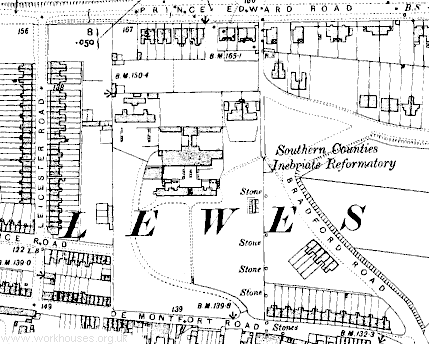
Lewes reformatory site, 1910.
The former workhouse blocks were allocated to groups of inebriate inmates classed as "well behaved", "manageable", "troublesome" and "very troublesome" as shown on the plan below (click on the plan for an enlarged version).
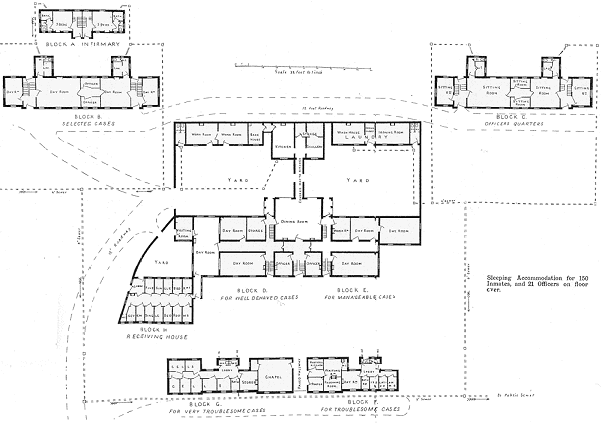
Lewes inebriate reformatory plan, c.1908.
The old Lewes workhouse buildings were demolished in 1960 to make way for the erection of the De Montfort flats.
Children's Homes
The old children's home on Lewes High Street remained in use after the opening of the De Montfort Road workhouse. It had closed by 1910 and a reservoir had been constructed on the site. By the 1920s, however, the union had established a children's cottage home at St Anne's, Lewes. In 1924, it could accommodate 40 children, with Miss C.L. Dickson as its Superintendent.
Staff
Inmates
Records
Note: many repositories impose a closure period of up to 100 years for records identifying individuals. Before travelling a long distance, always check that the records you want to consult will be available.
- East Sussex Record Office, The Keep, Woollards Way, Brighton, BN1 9BP. Holdings comprise: Guardians' minutes (1835-1930); Admissions and discharges (1917-30); Births (1914-30); Deaths (1914-30); Creed registers (1922-30); Children's Home admissions and discharges (1921-30); Accounts (1835-1921).
Bibliography
- Higginbotham, Peter Workhouses of London and the South East (2019)
- Carpenter P.K. (1996) Rev. Harold Nelson Burden & Katherine Mary Burden - pioneers of inebriate reformatories and mental deficiency institutions. J Royal Soc Med, 89: 205-9.
Links
- None.
Acknowledgment
- Thanks to Peter Carpenter for information on the Revd Burden and inebriate reformatories.
Unless otherwise indicated, this page () is copyright Peter Higginbotham. Contents may not be reproduced without permission.


